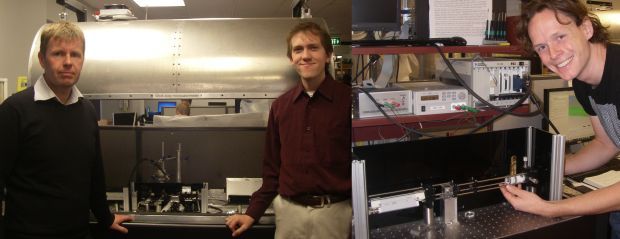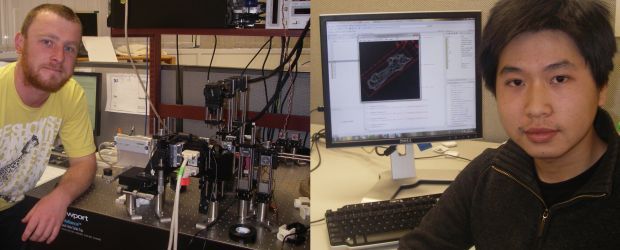Our Changing World for Thursday 4 July 2013
Great White Butterfly Eradication

Great white butterflies lay large yellow eggs in clusters, have large green caterpillars that feed in groups, and the adults are twice the size of the small white cabbage butterfly (images from DOC)
The great white butterfly, also known as the large white, is the big cousin of the familiar small white cabbage butterfly. It was first detected in Nelson in 2010, when the Ministry for Primary Industries decided it would be too hard to control, based on how quickly the small white cabbage butterfly had established. However, the great white butterfly established more slowly than expected, so a year ago a massive multi-agency eradication attempt swung into action, funded and led by the Department of Conservation. The great white butterfly has been declared an unwanted organism in New Zealand under the Biosecurity Act 1993.
Great white butterfly caterpillars eat brassicas (such as broccoli, cabbage, and cattle feed such as kale), along with nasturtium and honesty, and DOC is concerned that they could threaten small native cresses in the genus Lepidium, some of which are already rare. To date the butterfly has been found in Nelson city as far as Glenduan and Richmond, but have not yet been detected outside the city boundary.
In the last year project leader Richard Toft from Entecol and his team have made over 25,000 visits to houses and gardens in and around Nelson, and Alison Ballance joins him to find out is involved. Martin Rodd from the Department of Conservation explains how the eradication project is funded, and that the programme is currently under review.
If Nelson and Tasman residents find the great white butterfly, caterpillars or pupae they are asked to destroy them and then phone the MPI hotline 0800 80 99 66.
Duncan the Kōkako Returns

While Duncan was on the hop, he received frequent visits from people in the neighbourhood and even inspired kōkako cup cakes.
Auckland’s Ark in the Park kōkako population received an unexpected boost to its numbers in May, with the re-release of the wandering Duncan. Having disappeared shortly after his initial release in the Waitakere Ranges two years ago, conservationists feared the worst when Duncan’s transmitter stopped working.
Not known for its flying prowess, the kōkako instead relies on its powerful legs to bounce, leap and glide from tree to tree, and so it was a surprise when Duncan reappeared some 30 kilometres away in the suburb of Glendowie. While it is still unclear just how Duncan managed to cross the city, including a major motorway arterial, it is thought he used green corridors to hop his way safely through suburbia.
Capturing one of these rare birds in the bush can be difficult enough, but recapturing Duncan meant that rangers had to gain access to properties, busy roads and power lines and usually attracted curious locals as well as a team of visitors from the Department of Conservation, Forest and Bird, Auckland Council and the Tiritiri Matangi open sanctuary, all dedicated to working out a plan for his safe return. Lisa Thompson heads out to Glendowie and meets resident Catherine Gordon, Morag Fordham from the Supporters of Tiritiri Matangi, Hazel Speed from the Department of Conservation and Auckland Council's David Bryden.
Cardiac Myometer

Andrew Taberner (left) and Bryan Ruddy in front of the cardiac myometer, and PhD student Callum Johnston with his prototype thermometer (images: A. Ballance)
A team at the Bioengineering Institute at the University of Auckland is designing and building a cardiac myometer, which is an innovative miniaturised testing device that will be able to simultaneously measure five different parameters that are involved in the contraction of living heart muscle. The five are: force, contraction, heat production, oxygen consumption, and intracellular calcium ion concentration. The work is led by Andrew Taberner, is funded by a Marsden grant, and is a collaboration with Ian Hunter and the Bioinstrumentation Lab at MIT.
Research Fellow Bryan Ruddy is working on the the development of miniaturized actuation and control systems for use in muscle work-loop calorimetry. PhD student Callum Johnston is developing new temperature sensors for the measurement of muscle heat production, PhD student Alex Anderson is developing real-time imaging techniques for measuring sarcomere length, simultaneous with measurements of calcium ion concentration, and Ph D student Ming Cheuk is developing an Optical Coherence Tomography system to capture muscle geometry, and coordinate various measurements in a central electronic control system
Andrew Taberner and Bryan Ruddy featured in an Our Changing World story on the development of a needle-free jet injection system.

PhD student Alex Anderson with his microscope, and PhD student Ming Cheuk with a heart model on the computer (images: A. Ballance)
Lasers and Solar Cells

Alex Barker with the femtosecond laser, and with some of the devices he is studying (image: Dafnis Vargas)
Solar cells are currently made using silicon, in high energy, ultra-clean facilities, making them expensive to produce. Alex Barker, a PhD student in Justin Hodgkiss’ Ultrafast Spectroscopy group at Victoria University, is probing new plastic materials with a femtosecond laser as part of a Marsden-funded project. These materials may one day be used in solar panels printed roll to roll in the same way as newspapers and then put on house roofs, windows (because they are transparent) or even on backpacks.
At the moment silicon solar cells are about 15 to 20% efficient in converting sunlight into energy. The materials that Alex Barker is looking at are only about 3% efficient and need to reach much higher efficiencies to be useful. By understanding how light is turned into electricity in these materials, he hopes to improve their efficiency. A femtosecond laser is used to do this, because the sequence of events which take place when light is converted into electricity happen extremely quickly.